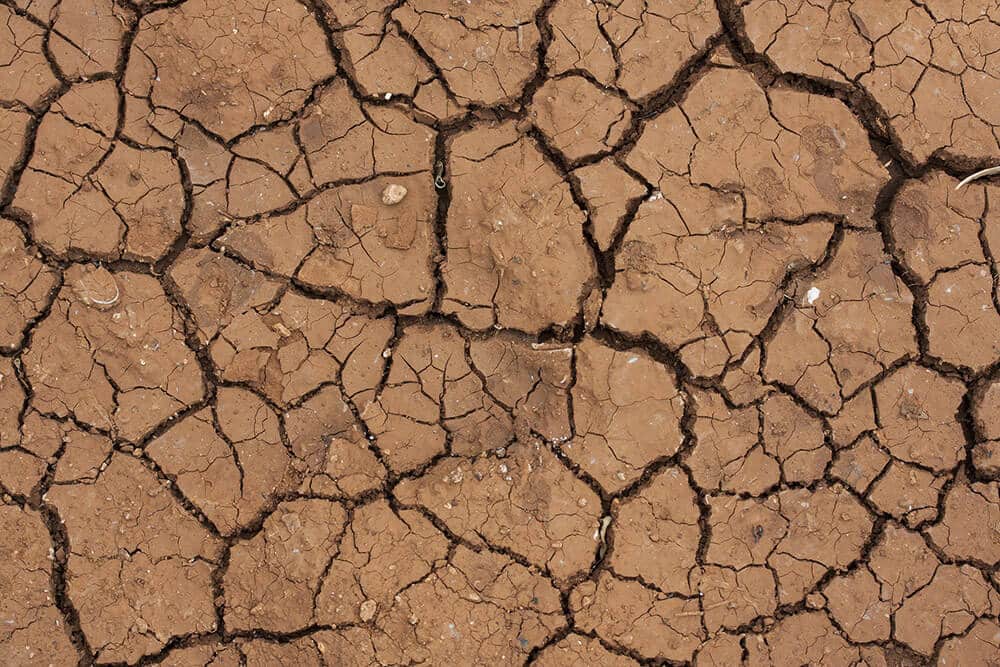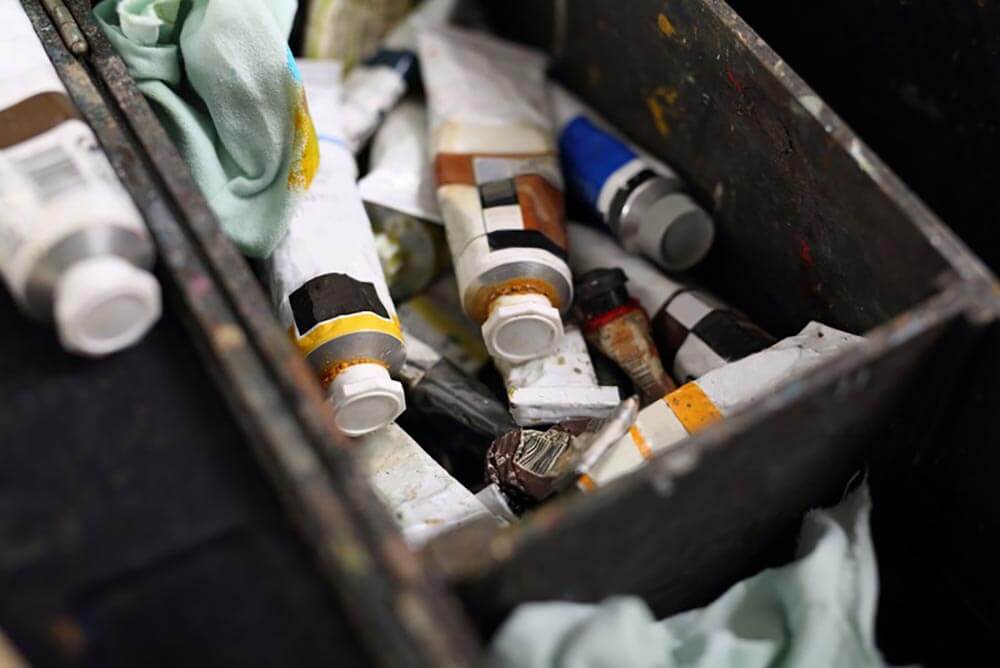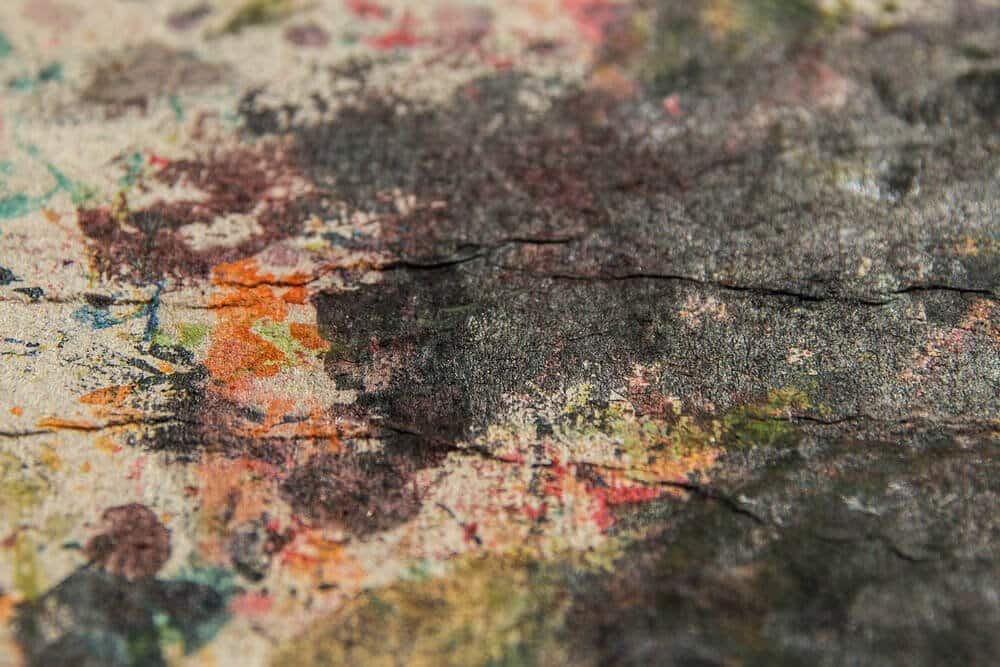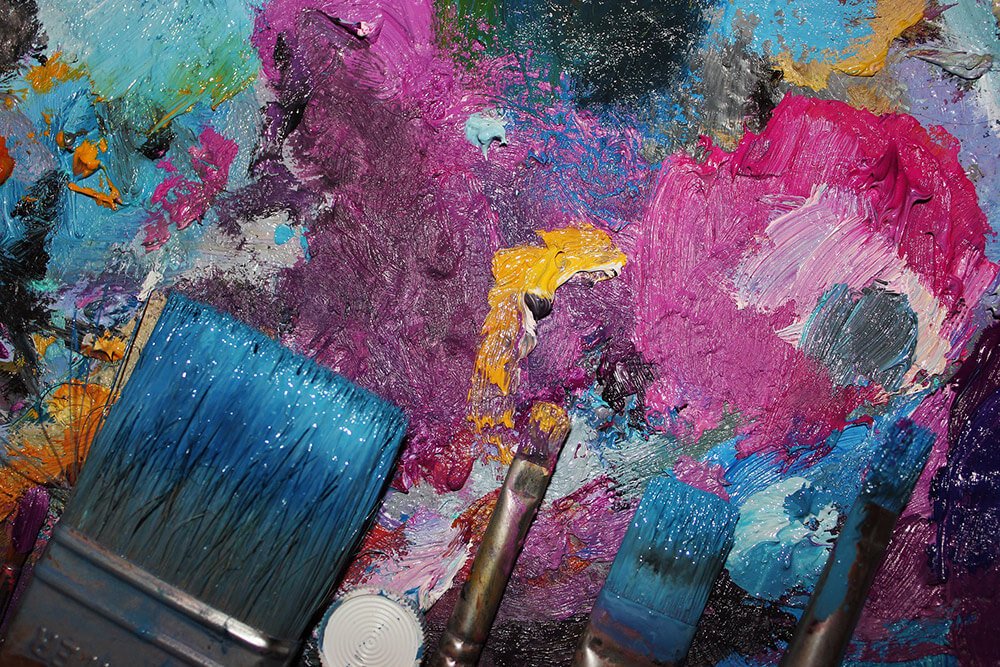One of the beautiful things about oil painting is that you can work on it for an extended period of time.
Whether you paint leisurely on the evenings after the kids are asleep or simply throughout the course of a day, oil paints can constantly be reworked.
Which is great…
…except for when you are trying to add another layer to your painting and the colors keep getting muddied up.
In short, this can be a bit frustrating and simply throw you off your momentum.
While oil painting is both fun and rewarding, there are sometimes we wish we could plan a bit better around the oil paint drying times so we can be a bit more productive.
Look:
WE would absolutely love to give you a straight answer on how long you should expect oil paint to dry.
However, as simple of a question that it might seem, there’s actually a lot going with your oil paints than you may realize.
Let’s take a quick minute to examine the oil drying process a bit closer (promise this is no longer than 2 minutes reading time):

Table of Contents
Oxidation Rather Than Evaporation
If you are coming from a watercolor, gouache, or acrylic background, you will instantly realize how these two mediums differ significantly.
Other than just the finished results of the artwork, their drying process are completely unrelated.
Watercolors evaporate when exposed to air.
Therefore, you can literally blow dry your watercolors in only a few minutes…and they would be ok to touch.
Oil on the other hand, oxidizes rather than evaporates.
Now we don’t want to get too much in the weeds with the difference, just know this:
When oil is exposed to air, a chemical process will begin where there is a loss of electrons and the pigments and oil will begin to harden.
Therefore, placing a fan on top of your finished oil painting, while it may slightly speed up the results, the effects won’t be nearly as quick as you experience with a watercolor painting.

Another Large Factor On How Long It Takes To Dry Oil-Based Paint Is Your Environment
The location and weather of your studio will have the biggest impact on drying times for your oil painting.
If you live in a warm and dry climate (think desert), you will have the shortest drying times for your oil paints.
You can typically see results for most pigments in as little as 1 or 2 days.
Now, if you live in a humid or colder climate, this will lengthen the drying times significantly.
While some artists in those arid climates may see their layers dry up in only a couple of days, you likely won’t see desirable (dry) results until day 4 or 5.
To further complicate things, if your studio is in a basement, this will also likely have an impact on the drying time as basements often have higher humidity.
So be sure to consider this if you are planning on setting up a studio or letting your pieces rest while you aren’t currently painting.

Pigment & Oil Ratios Will Vary Across Manufacturers And Tubes
So get this:
If you do an evening painting that is rich in cobalt blues, sap green, and titanium white, your painting will likely dry fully within a couple of days.
But….
…if you do a painting with warmer colors like alizarin crimson or rich in some cadmium hues, your painting may take a full week to dry.
Crazy, right!?
Remember before we said we couldn’t give you just one answer for how long an oil painting will take to dry?!
This is why!
Seriously, both pigments and oil amounts have a direct impact on drying times.
Whether you are using pigments that have been naturally sourced from minerals or those created synthetically in a lab they will react very differently.
Remember we were saying that oil paint dries through oxidation?
Well that chemically-induced process can vary greatly depending on the makeup of the pigments in question.
Now you might be wondering:
What about the oil to pigment ratio? Surely more oil means longer drying times right?
Well, to be quite honest:
We were thinking the same exact thing too!
Unfortunately though, based on our preliminary research, the chemical reaction of the pigments still takes precedence over oil when it comes to drying times.

General Guidelines On How Long It Takes Oil Paint To Dry
With all this talk about chemicals, pigment to oil ratios, and the environment, we are going to give you some very loose guidelines that you can follow.
These are starting points for time budgeting reasons.
However, you shouldn’t expect this to be exact in your scenario when taking all the above points we covered so far into consideration.
Underpainting = ~ 1 Day
Remember the fat over lean principle that you likely learned in Art school or from an art blog?
If not – here’s a quick side note:
Fat over lean is a painting technique employed by many artists. This reinforces that you should be painting in layers. Thin layers go under the thick layers.
This not only prevents cracking of the paint itself, but also ensures that you can get quicker drying times with your painting.
Well, the underpainting is essentially the wash or base layer where you define the shapes and general composition of your piece.
Underpaintings typically consist of a single color (usually Burnt Umber – which features a really quick drying time) and will be ok to paint on top within a day of application.
If the layer is really thin, and the conditions are right, you may be able to paint on top of the underpainting in the same day.
Note: To thin your painting you will want to use either a mineral spirit, turpentine, or oil of spike lavender.
Overpainting =~ 3 to 12 days
Most of the overpainting will be dry to touch within about 3 to 12 days.
The wide range for this part of your painting largely has to do with the type of paint you are using and its thickness.
Again, the chemically induced oxidation process of the different pigments can have a huge impact on the drying times (as seen in this wide range).
While this layer may be where most of your work is happening within the painting, you will want to always exercise caution and not try to rush your piece.
Secondly, given that this part of your painting can take more than a week, you will always want to store your painting in an area that isn’t prone to being bumped or touched from others – especially kids 🙂

List Of Popular Oil Paint Drying Times
Based on our research and what other artists have reported, we wanted to put together this handy list that you can reference for drying times for some of the more popular pigments that likely are in your studio.
Fast (~ 1 Day)
- Burnt Umber
- Burnt Sienna
- Prussian Blue
- Cobalt Blue
- Raw Sienna
Medium (~2 to 5 Days)
- Leads
- Zincs
- Viridian
- Titanium White
- Cadmiums
Long (~5 to 12 Days)
- Alizarin Crimson
- Cadmium Hues
- Quinacridones
- Ivory Black
- Sap Green
Fat Over Lean – Meet Slow Over Fast
Sometimes us artists like to get a bit carried away…
…and that’s not a bad thing at all!
While we covered the fat over lean principle above, some artists also like to employ what’s called the ‘slow over fast’ principle.
As you likely inferred from the name, slow over fast simply refers to the paint drying times and how you layer them.
While we aren’t one to bending at the will of oil paint drying times, some artists do like to try and perform with the highest of efficiencies.
Should this make sense to you, we would recommend experimenting heavily with your own personal oil paints and see what type of drying times you see.
Keep notes of these drying times and then adopt them into the slow over fast painting technique.

Tips To Speed Up Drying Times Of Oil Paint And Improve Workflow
Here are a few tips that other artists employ to speed up the drying times of their work.
Fast Drying Solutions
So, when it comes to drying your painting, are you really at the will of the environment and the chemical composition of the painting?
No!
To try and make your oil paint dry a bit faster, we would recommend always having a fast-drying solution on hand.
This not only will help to make your painting dry faster, but will generally make you a much more productive artist as well.
While there are numerous fast-drying solutions on the market, we want to take a moment to talk about two that many artists are already likely familiar with:
Liquin and Galkyd
Both of these products work to thin the oil paint itself (it’s not a traditional solvent) and to hasten the drying time.
Rather than employing an odorless mineral spirit or turpentine, both of these products rely on an alkyd resin.
In recent years, these mediums have become a staple on nearly every oil painters palette as they provide incredible results.
Commonly found at online retailers like Amazon and Dick Blick, if you don’t already have a bottle of this in your studio, we would definitely suggest picking one up today.

Acrylic Underpainting
The lovely part about oil painting is that it’s incredibly versatile and can stick to almost anything.
When you are trying to get work done and don’t have a day to wait for an underpainting to dry, then you might want to consider acrylic.
While acrylic can completely destroy your brush if it isn’t cleaned immediately after use, it is incredibly cheap and fast drying.
To thin acrylic paint for an underpainting, you just simply need to add some water (no, not odorless mineral spirits).
In most cases with acrylic, you can expect a dry touch finish in only a half hour time.
Talk about efficiency!
Warm Dry Air Is Best
Depending on where you live you may want to consider placing your art drying racks in a strategic location.
For instance, in northern states where big radiators are a fixture to any old building, the warm and extremely dry air that they permeate will be perfect for hastening the oxidation process of an oil painting.
However, you do want to exercise caution.
We wouldn’t recommend keeping your paintings any closer than 4 feet from the radiator, as such a drastic change in temperature when the radiator goes on and off may cause cracking on the surface.
Another popular location that may artists may use as well will be their garage.
Typically a much warmer environment than the rest of the house, a garage is also a well ventilated area that provides plenty of space for warm and dry airflow with a fan.
All of this together will help to ultimately increase the oxidation process so you can get back to work on your painting.

Is One Painting Really Enough?
Lastly but not least, multitasking:
While this really isn’t a technique to dry your painting faster per se, if you have the space, we would recommend working on perhaps 2 or even 3 paintings at any given time.
Not only will this allow your artwork to dry between sessions, but it also gives you the opportunity to always be painting and maximizing efficiency.
Closing Thoughts On Drying Your Painting
Taking all the above into account, you should now have a better idea on how to budget your time for future pieces of work.
Of course the quick use of Galkyd or Liquin can help speed up the process entirely, however, you don’t want to get too reliant on these solutions with every single piece that you do.
Going ‘naked’ per se with your oil painting will give you a moment to appreciate what is going on at the surface of your canvas when two or more colors are mixed together.